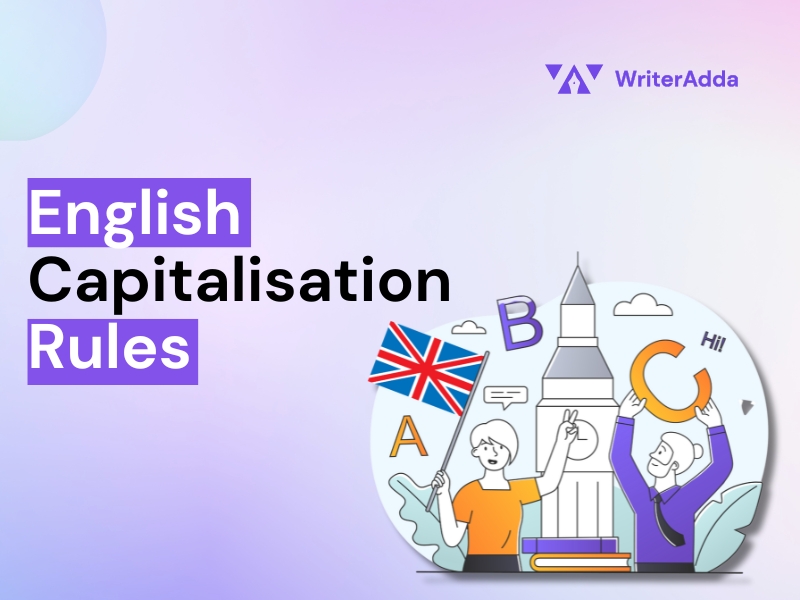The English language – a beautiful tapestry of sounds, meanings, and, of course, rules. Among these rules, capitalisation stands as a subtle yet significant determinant of proper writing. Misplace a capital letter, and you could change the tone, meaning, or even the reception of your content.
So, buckle up, as we embark on a journey through the winding lanes of English capitalisation rules. By the end of our voyage, you’ll be navigating these lanes with the confidence of a seasoned driver!
1. Capitalise the First Word of a Sentence
The first rule is simple and straightforward: always capitalise the first word of a sentence.
E.g., “She loves to dance.”
2. Proper Nouns and Adjectives
All names of specific people, places, or things are capitalised. This includes brand names, monuments, countries, etc. Additionally, adjectives derived from these proper nouns also get capital treatment.
E.g., “She visited Paris during the French Revolution.”
3. I – The Singular Personal Pronoun
The letter “I” is usually used to denote oneself and gets special capital treatment wherever used. No matter where it’s placed in a sentence, the pronoun “I” is always capitalised.
E.g., “You and I will meet at the park.”
4. Titles and Headings
In titles and headings, you should capitalise the first and last words, regardless of their part of speech. Additionally, capitalise all nouns, pronouns, adjectives, verbs, adverbs, and subordinate conjunctions.
E.g., “The Lion, the Witch, and the Wardrobe.”
5. Days, Months, and Holidays
Names of days, months, and specific holidays are capitalised, but not the seasons.
E.g., “She loves the colours of autumn, especially in October.”
6. Titles Preceding Names
When a title precedes a name, it should be capitalised.
E.g., “President Obama,” not “President Obama.”
7. Major Words in Works of Art, Movies, Books, etc.
Similar to titles and headings, major words in titles of books, movies, art pieces, and other works should be capitalised.
E.g., “Pride and Prejudice” or “Mona Lisa.”
8. Directional References
Capitalise specific regions or cultural areas but not when referring to directions.
E.g., “I love the West Coast vibes,” but “Drive west for two miles.”
9. Periods and Events
Specific periods, events, or historical epochs are capitalised.
E.g., “The Middle Ages,” “The Renaissance,” or “World War II.”
10. Institutions, Organisations, and Government Bodies
Names of specific institutions, organisations, and government entities are always capitalised.
E.g., “Harvard University” or “United Nations.”
11. Races, Nationalities, and Tribes
Names of races, nationalities, and specific tribes are capitalised.
E.g., “Native Americans,” “Hispanic,” or “Zulu.”
12. Religions and Deities
Names of specific religions, their followers, and specific deities are capitalised. However, non-specific references to a god are not.
E.g., “Christians believe in the teachings of the Bible,” but “The ancient Greeks believed in many gods.”
Shurley English Capitalisation Rules
Shurley English, a renowned English curriculum, adopts a jingle-based approach to teach students grammar, including capitalisation rules. Through mnemonic aids and catchy jingles, it simplifies the complexity of English grammar, making it both engaging and memorable for learners. Let’s delve into the capitalisation rules as taught by Shurley English for easier understanding:
1. Jingle into Sentence Beginnings
Just as with standard English rules, Shurley English emphasizes the importance of starting every sentence with a capital letter.
Jingle snippet: “At the sentence start, a capital imparts…”
2. Proper Noun Alert!
Shurley English ensures students recognize proper nouns – names of specific people, places, and things – and capitalise them appropriately.
Jingle snippet: “For people, places, days, and more, capitalise to score!”
3. ‘I’ Stands Tall
With its unique emphasis, the curriculum drives home the point that the pronoun ‘I’ is always capitalised, no matter where it stands.
Jingle snippet: “Whether alone or in a mix, ‘I’ gets the capital fix.”
4. Titles and Honorifics
Whether you’re addressing the “Mayor” or writing about “Aunt Jane”, Shurley English uses jingles to remind students about the capitalisation of titles and honorifics.
Jingle snippet: “With a title before the name, a capital is a claim.”
5. Special Days and Holidays
From “Monday” to “Christmas”, the curriculum underlines the need to capitalise on specific days and holidays.
Jingle snippet: “On days and holidays, capitals light the ways.”
6. Books, Films, and Artworks
Teaching students to capitalise major words in the titles of books, movies, and art, Shurley English uses its characteristic jingles to make the rule catchy.
Jingle snippet: “In titles we display, capitals lead the way.”
Subtle Difference in British Capitalisation Rules
While the core capitalisation rules are shared between American and British English, a few variations set the British style apart. Some of the British capitalisation rules are:
1. Titles and Honorifics
British English tends to use fewer capital letters with titles. For instance, “the queen” is common unless directly referring to Queen Elizabeth II.
2. Institutions and Job Roles
In British English, job titles and roles often appear in lowercase, especially in a non-formal context.
E.g., “She was promoted to director” instead of “She was promoted to Director.”
3. Educational Stages
In British English, educational stages like ‘primary school’ or ‘secondary school’ are typically in lowercase.
Common Pitfalls to Avoid
As we navigate the world of capitalisation, there are a few treacherous spots to be wary of. Even the best of writers can occasionally stumble on these. Let’s dive deeper into some of the most common pitfalls:
Overcapitalisation: This refers to the unnecessary use of capital letters in places where lowercase would be correct. For instance, writing “The Sunset looks Beautiful from the Beach” rather than “The sunset looks beautiful from the beach.”
Overcapitalisation can distract the reader and might lead them to believe certain words are proper nouns or more important than they actually are.
When in doubt, it’s often better to err on the side of caution. If you’re unsure whether a word should be capitalised, it’s generally safer to go with lowercase unless the word is a proper noun or at the beginning of a sentence. Remember, unnecessary capitalisation can come off as shouting in written form, so use it judiciously.
Inconsistency: This refers to capitalising a term or title in one part of a document and then using lowercase for the same term elsewhere. For example, writing “The company will launch its new Software next month” and later mentioning “the software has new features.”
Inconsistency in writing can confuse readers and make the document appear unprofessional or carelessly edited. It can also change the perceived importance of the term in question.
If you decide on a capitalisation style for a specific term, be consistent throughout the entire document. This is particularly vital for official documents, academic papers, or any professional publication. Consider creating a style guide or a list of terms for longer projects to ensure consistency.
Conclusion
Proper capitalisation is akin to dressing up your sentences in a formal suit. They might still make sense in casual attire, but they look so much more refined and structured in their best garb. With these rules in hand, you’re well on your way to mastering the art of English capitalisation. Happy writing!




